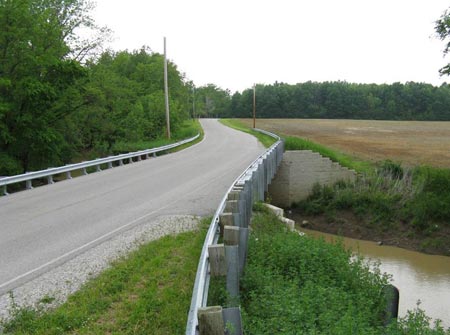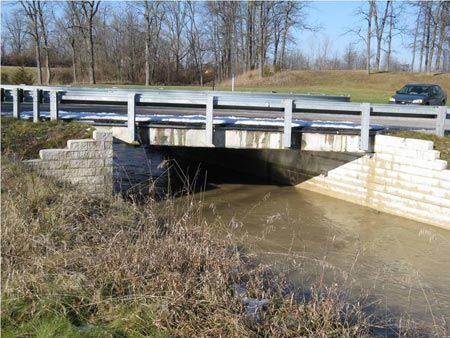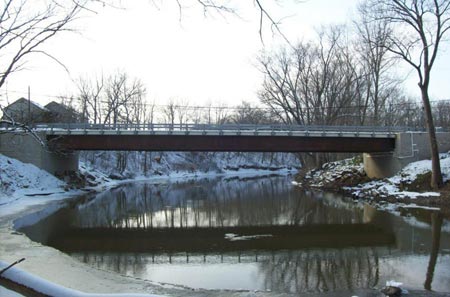U.S. Department of Transportation
Federal Highway Administration
1200 New Jersey Avenue, SE
Washington, DC 20590
202-366-4000
Focus
| Accelerating Infrastructure Innovations |
Publication Number: HRT-11-012
Date: April 2011
Printable Version (.pdf, 1 mb)
A fast and economical solution for achieving the goal of accelerated bridge construction, the Geosynthetic Reinforced Soil Integrated Bridge System (GRS-IBS) was initially developed by the Federal Highway Administration (FHWA) as part of its Bridge of the Future initiative in 2002. Now, following the success of GRS-IBS technology demonstrations in States such as Ohio and New York, one component of the bridge of the future has arrived.
Learn how to put the GRS-IBS system to work for you with FHWA's new Geosynthetic Reinforced Soil Integrated Bridge System Interim Implementation Guide (Pub. No. FHWA-HRT-11-026), which takes an engineer through the site selection, design, and construction process. Also available is a companion document, Geosynthetic Reinforced Soil Integrated Bridge System Synthesis Report (Pub. No. FHWA-HRT-11-027), which substantiates the design method and presents case histories for GRS-IBS bridges built to date.
"GRS-IBS can be built at a lower cost, with faster construction and improved performance, and can be used to build single span bridges on all types of roads," said Jennifer Nicks of FHWA. "This method of bridge support blends the roadway into the superstructure to create a jointless interface between the bridge and the approach roadways." Compared to standard bridge construction, transportation agencies that use GRS-IBS can cut their costs by 25 to 60 percent.
FHWA selected GRS to be one of the technologies promoted by its new Every Day Counts (EDC) initiative in 2010. The EDC initiative is designed to identify and deploy proven, ready-to-go innovation aimed at shortening project delivery, enhancing roadway safety, and improving environmental sustainability (see June 2010 Focus). For more information about EDC, visit www.fhwa.dot.gov/everydaycounts.

Researchers at the U.S. Forest Service and the Colorado Department of Transportation (CDOT) pioneered the early development of the GRS technology. FHWA then worked with CDOT to further refine it. Among the States that have successfully used the technology to date is Ohio. Defiance County, Ohio, built the Bowman Road Bridge, the first bridge in the world to use GRS-IBS, in 2005. Use of the technology cut costs by at least 25 percent compared to conventional approaches and reduced the construction time by 2 weeks. Since then, Defiance County has built a total of 23 bridges using GRS-IBS. "As we have used the technology more, we have achieved even greater savings. All of the bridges are performing very well to date," said Warren Schlatter, Defiance County Engineer.
GRS-IBS consists of three main components: the reinforced soil foundation (RSF), abutment, and integrated approach. The RSF is composed of granular fill material that is compacted and encapsulated with a geotextile fabric. This method provides embedment and increases the bearing width of the GRS abutment. The abutment, meanwhile, uses alternating layers of compacted fill and closely spaced geosynthetic reinforcement to provide support for the bridge, which can be placed directly on the abutment without the need for a joint or cast-in-place concrete. Construction of the abutment is as easy as 1-2-3: a row of facing blocks, followed by a layer of compacted granular fill, and then a layer of geosynthetic reinforcement. This process is repeated until the required abutment height is reached.
For the third component of the system, GRS is used to construct an integrated approach road to the bridge, alleviating the common "bump" caused by differential settlement between bridge abutments and approach roadways.
The GRS technology is extremely durable and, if properly constructed, can perform well in earthquakes. Other advantages include that the GRS-IBS can be built with readily available materials, using common construction equipment, and without the need for highly skilled labor. GRS-IBS also offers convenience and design flexibility, as the system can be built in variable weather and adapted easily in case of changing or unforeseen conditions. The construction of the abutment can be contained within its own footprint, reducing the project's environmental impact and the size of the needed work zone.
FHWA's Implementation Guide details how to design and construct GRS-IBS, covering such topics as:
The section on construction walks users through each step of the process, including labor and equipment requirements, site preparation, compaction, reinforcement, placement of the superstructure, approach integration, and site drainage.
Also featured in the guide is a design example for the Bowman Road Bridge in Defiance County, Ohio. The design example outlines the project process, including establishing the project requirements, performing a site evaluation, determining the layout of GRS-IBS, calculating loads, conducting both internal and external stability analyses, and implementing design details.
The Geosynthetic Reinforced Soil Integrated Bridge System Interim Implementation Guide and its companion synthesis report are available at www.fhwa.dot.gov/publications/research/infrastructure/structures/11026/index.cfm. For more information about GRS-IBS, contact Jennifer Nicks at FHWA, 202-493-3075 (email: jennifer.nicks@fhwa.dot.gov). To learn more about FHWA's GRS-IBS Every Day Counts initiative, contact Daniel Alzamora at the FHWA Resource Center, 720-963-3214 (email: daniel.alzamora@fhwa.dot.gov). For additional information on Defiance County's GRS bridges, contact Warren Schlatter, Defiance County Engineer, at 419-782-4751 (email: dce@defiance-county.com).

The Bowman Road Bridge in Defiance County, OH, was the first bridge in the world to use the Geosynthetic Reinforced Soil Integrated Bridge System (GRS-IBS).


© Defiance County, Ohio
GRS-IBS bridges built in Defiance County, OH, include the Vine Street Bridge (top) and the Tiffin River Bridge (bottom).